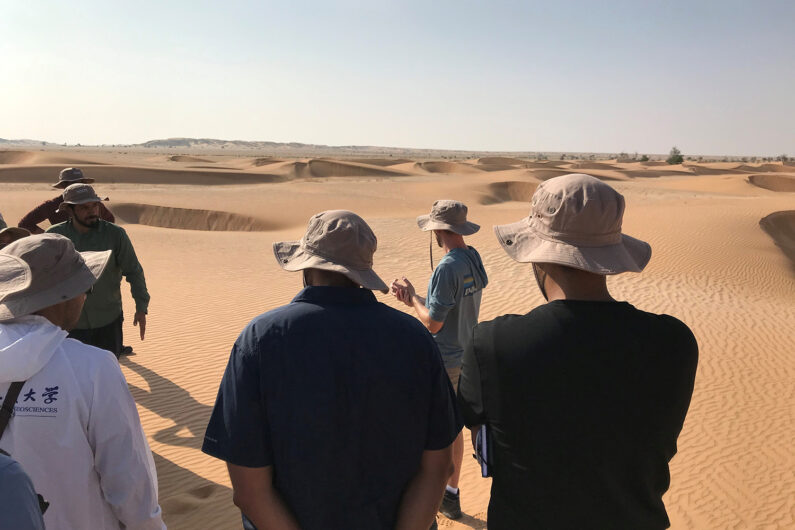Four questions for Mathieu Lapôtre on Dune
A Stanford dune expert discusses watching desert-based movies from the perspective of a geoscientist, the realities of otherworldly dunes, and what his research can tell us about the ancient environment of Earth and other planets.

Mathieu Lapôtre (center) in Oman, just a few hundreds of kilometers away from one of the Dune filming locations near Abu Dhabi. (Image credit: Gretchen Gillis)
The Dune books and movies are science fiction, but otherworldly dunes are very real – and Stanford geoscientist Mathieu Lapôtre studies them. So, in acknowledgement of Dune: Part Two, we asked Lapôtre four questions about studying dunes across the solar system, and what he thinks of sci-fi movies on dune-covered alien planets.
“There are a lot of geoscience- and space-based movies that are meant to be dramas, but end up being more like comedies to geoscientists,” said Lapôtre, who is an assistant professor of Earth and planetary sciences in the Stanford Doerr School of Sustainability.
1. Many of the desert scenes in Dune (2021) were filmed in the deserts of the Arabian Peninsula and included shots of massive, rolling sand dunes. Why does that area have such iconic sand dunes?
To make sand dunes, you need two things: a supply of sand, and wind. You need the sand grains to hop along the bed in a curved, ballistic trajectory. That only happens for grains that are the size of sand, which to a geologist has a very precise definition: It’s basically any rock fragment between 62.5 microns and 2 millimeters in diameter.
There are two main kinds of environments where you have both sand and wind. One is the beach, and the other is in arid deserts. And so, in the Arabian Peninsula, you have this relatively flat swath of land that happens to have a really good source of sand: old sandstones that formed hundreds of millions of years ago, before plants even existed on Earth.
Some of the movie was shot near Abu Dhabi, which is on the downwind end of that dune field, and other scenes were shot in Jordan, which is closer to where the sand comes from.
2. How do dunes on other planets differ from those on Earth?
This is a question that’s really at the heart of our research. Pretty much everywhere we’ve looked in the solar system, we’ve seen dunes.
We see dune fields on Venus, even though conditions on Venus are very different from conditions on Earth. The surface is extremely hot. And the planet has a really, really thick atmosphere that does not generate strong winds at the surface.
We also see dune fields everywhere on Mars, where the environment is very different from both Earth and Venus. The atmosphere is very thin, and it’s very cold. There’s a lot of sand, some of which formed from erosion of rocks billions of years ago, when Mars had water at its surface.
Then moving further outward in the solar system, we have Titan, which is a moon of Saturn. Titan, in a way, is about as far as it gets from an Earth-like environment. The temperature is about minus-290 degrees Fahrenheit – so cold that water ice behaves like rock. Gigantic dune fields wrap around the equator of Titan, but the sand there is not made of quartz like on Earth. Instead, it’s likely made of these weird hydrocarbon compounds that rain out of the atmosphere.
There’s also evidence for dunes on Pluto, which has an even thinner atmosphere than Mars, and even on the 67P comet, which has no atmosphere at all. So as long as you have grains and wind, you can form dunes. The fact that we are seeing dunes across this crazy diversity of surface environments tells us something fundamental about the physics of dunes. Then, you can apply that physics back to Earth. One thing that I’m excited to do is use this new knowledge about dunes on Mars to reconstruct the history of Earth’s atmosphere in the Precambrian, by looking at the deposits of some of the oldest fossilized dunes on Earth.
3. Has studying deserts changed how you watch desert-based movies (Dune, Star Wars)? Do you notice any inaccuracies?
One example that comes to mind is The Martian, actually. Everything in the movie is pretty accurate scientifically, except for the very premise of the movie. The movie starts with a giant dust storm that is so strong that Matt Damon is blown away by the wind, resulting in him being stranded on Mars. There are giant dust storms on Mars, but the winds are barely strong enough to move the sand at the surface. There is no way for Martian winds to turn Matt Damon into a grain of sand. And without that happening, there’s no movie, right? But, except for this slight inaccuracy, the movie is really great.
4. How will your research on dunes on Mars and other planets aid future space exploration missions?
In 2015, the Curiosity rover found a new type of dune on Mars that we didn’t even know could exist. The rover found these meter-scale dunes on top of the more regular-sized dunes. And sometimes the rover might have to cross those smaller dunes, or ripples, and the rover can get stuck in the sand (it’s happened before). And so, when I was a PhD student, I worked with engineers at NASA’s Jet Propulsion Lab on designing tests for the new wheels that would go on the Perseverance rover, which is now on Mars.
Those ripples on Mars caused us to rethink the formation of dunes. That has really cool implications, because if you can reconstruct their size, then you can start inferring things about the environment in which the dunes formed. Because of that, we’ve been able to reconstruct the density of the atmosphere on Mars from about 3.8 billion years ago.
Some of our work on the dunes of Titan might also have implications for NASA’s upcoming Dragonfly mission, which is going to send a car-sized quadcopter to Titan. It’s going to hop around the surface, close to the equator, near sand dunes, which it is likely going to explore. So, understanding when the sand moves and what it’s made of has implications for the mission’s science investigation, but also for more practical issues, like how to operate the quadcopter.

